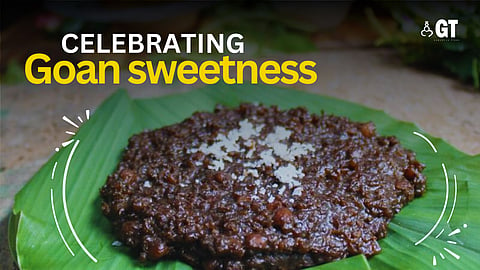

DANUSKA DA GAMA
Bebinca reigns as the crowned queen of Goan sweets and you rave about it, and that’s probably why we’ve ignored other traditional Goan sweets that have remained relatively forgotten but not all that unknown. A sweet secret, we’re discussing today is atol (pronounced: aah tall)
Unlike bebinca’s fame, atol tiptoes through the culinary landscape, quietly delighting those who chance upon it. Picture this: a dark brown coarse confection, reminiscent of halwa but with the earthy sweetness of jaggery, grainy dal and cardamon or turmeric leaves that can be used to give it a distinct subtle flavour.
It’s more than just a sweet wrapped in nostalgia that tells stories of the past, of Goa’s tradition, its sweet taste lingers on long even after the last bite.
Atol is made with humble ingredients – chana dal (split Bengal gram) and parboiled Goan (ukde) rice. These are pressure-cooked until tender. To this is added grated coconut and black, pyramid looking palm jaggery (maadache godd). The mixture is allowed to simmer till it thickens to become a dark brown halwa-like looking confection. It is then laid out on turmeric or banana leaves, or greased plates and sliced into squares or diamonds once cooled.
Atol is a cherished Goan sweet that holds special significance, especially during harvest time, though it is made all-year round. It was traditionally prepared in rather large quantities by landlords (bhatkars) around October to celebrate a successful harvest.
“The bhatkar’s house would prepare atol and distribute it among the villagers. It was a way of sharing the bounty and spreading joy during the harvest season,” shares Crescy Baptista from South Goa, who heard this from the elders in her family.
The sweet graces the tables on June 24, the feast of Sao Joao, on August 1 as there is a belief that one should eat something sweet on this day and on August 15 which is celebrated as the feast of Our Lady of Assumption that coincides with Independence Day.
Of late, Atol is getting more love and respect as it is prepared by the elders in the family, mostly in Catholic homes. Today, youngsters who pride themselves of being guardians of Goa’s culture, tradition and heritage have been appreciative of such age-old recipes.
Atol is not only delicious but also nutritious. The combination of rice, coconut and jaggery provides energy and essential nutrients. And a lot of the traditional Goan sweets, were meant to be healthy. At teatime in Goan households, atol is commonly served as ‘merenda’ (tea-time snack).
However, as much as one would like to buy off the counter, just as easily as they do with bebinca and dodol, it isn’t commercially available. A few people in villages across the State prepare atol and take orders for this sweet, which is sold in kilograms or by the large plate (taat).
If you’re lucky, when in Goa you could inquire at some local bakeries and sweet stalls in Mapusa and Margao that may have it occasionally.
However, your hope remains in The Goan Kitchen in Margao, which has the item on its menu on a weekly basis. But, if you’re dying to know what the fuss about atol is all about, you could place an order with The Goan Kitchen in advance and enjoy it.
Here, Oliver Fernandes and Crescy Baptista have been on a mission reviving Goan culinary practices and promoting Goan delicacies. You can always check their Instagram page for the menu.
Atol is more than a sweet. It is a cultural tradition that bring people across generations together, celebrating abundance and the joy of sharing a legacy - most of all preserving Goa’s culture through its culinary brilliance.